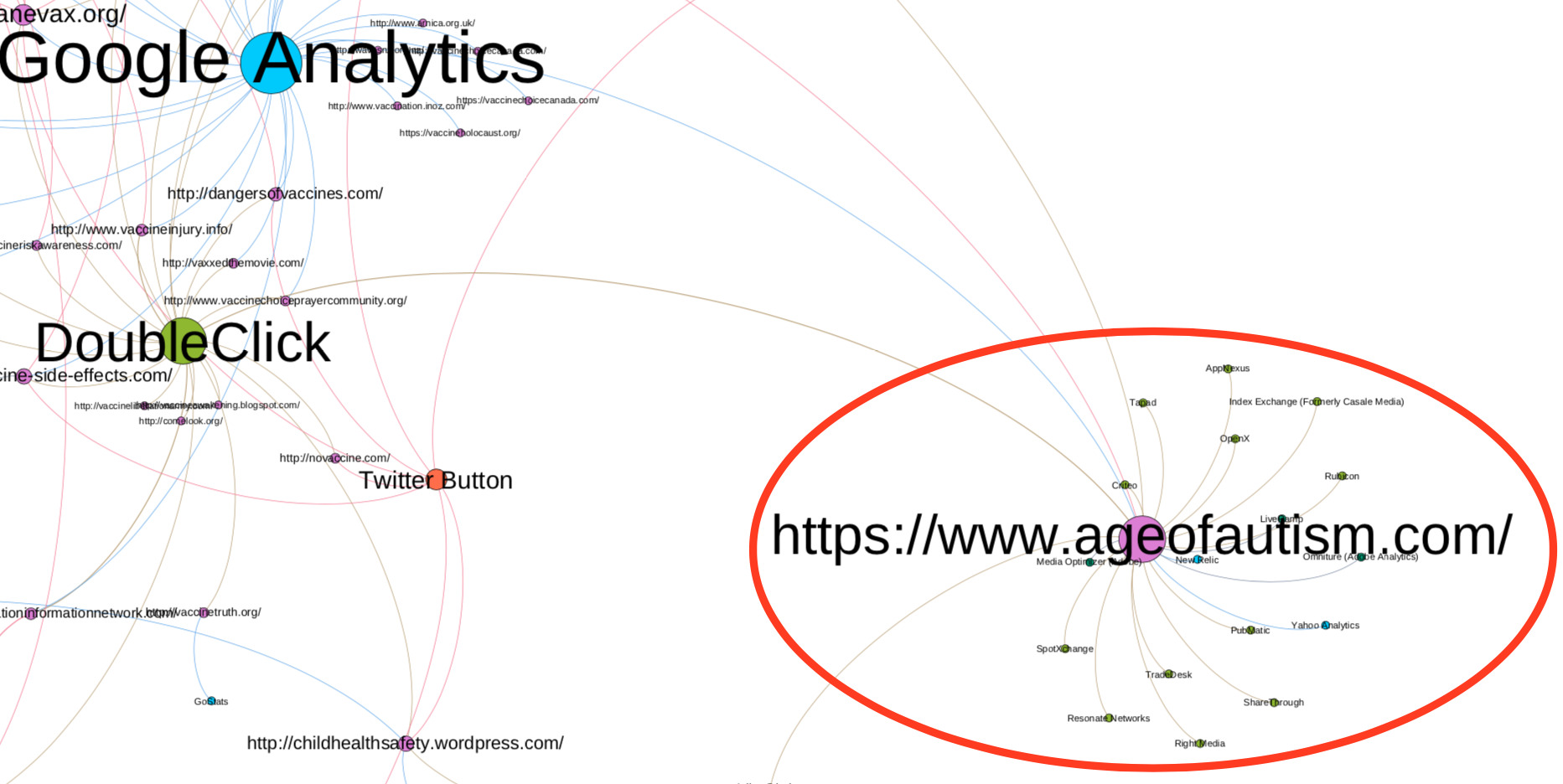By Rory Smith, Liliana Bounegru and Jonathan Gray
This article is the first in our Digital Investigations Recipe Series, a collaboration between the Public Data Lab, Digital Methods Initiative, Open Intelligence Lab and First Draft. It is designed to lift the lid on advanced social media analysis. Please read our example investigation below first and then refer to the recipe How are they funded? Investigating ad trackers with Gephi and the DMI Tracker Tracker tool for a step-by-step guide on how to conduct a similar investigation.
The growth of the anti-vaccination movement is, in many ways, unsurprising. The Covid-19 pandemic has resulted in a chaotic and uncertain information ecosystem, creating the perfect conditions for rumors and conspiracies to thrive. The anti-vaccination movement, while still an online minority, is loud, increasingly networked and a significant source of vaccine misinformation. But how does the movement support itself and how might it be monetizing misinformation?
We know the anti-vaccination movement benefits from millions of dollars from different donors. But what kinds of technologies, infrastructures, products and services do online publishers of vaccine misinformation use and depend on to make money? And what can trackers — those small bits of code embedded in websites that are used to do things such as monitor engagement, quantify website visits, track user behavior and assess the effectiveness of ads — tell us about these strategies?
Some of the biggest social media and tech platforms, including Google (which owns YouTube) and Facebook, recently stated they will take more aggressive action against posts and videos containing Covid-19 vaccine misinformation. But these companies are more than simple platforms that host posts and videos. Google and Facebook also provide a suite of tools for website publishers, including trackers to monitor audience engagement, create networks of followers and target ads.
To find out how anti-vaccination websites were using these platform-provided tools, we conducted an analysis of the trackers used by 60 anti-vaccination websites. Using the Digital Methods Initiative (DMI) Tracker Tracker tool with Gephi (a network analysis tool that visualizes the relationships between actors and the social structures that emerge through these relationships), we reveal how these sites employ vast configurations of advertisement, social media and analytics trackers to drive traffic, build audiences and monetize the activity of their users.
We found that anti-vaccination websites, despite the latest proclamations from the large platforms, have at various points installed and configured different combinations of analytics trackers to facilitate the flow of traffic to their websites, the building of audiences and communities, and the targeting and serving of ads. While some of these sites may have been blacklisted by the tracker providers, this nevertheless gives an indication of the important role that the technologies of these companies have played in publishing anti-vaccination websites.
As you can see in this network analysis (see this video for a more detailed explanation), Google Analytics, Facebook Connect and DoubleClick (which was acquired by Google in 2007) are some of the most pervasive trackers among the 60 anti-vaccination websites we analyzed. The size of these dots (or nodes) as well as their location at the center of the image signify their importance in the network. The different lines (or edges) that are tentacles from these popular trackers highlight the different connections between the tracker technologies and other websites. While many anti-vaccination websites shared these tracking technologies (Google Analytics, Facebook Connect and DoubleClick), not all sites employed the same publishing or monetization strategies.
The network of trackers connected to anti-vaccination websites. Image: First Draft
One website (see the image below) used a particular set of trackers associated with “programmatic advertising” — where different algorithms bid on advertisements in fractions of a second. As you can see, it is relatively separate (located in the bottom right of the image) from the main cluster of nodes. This is because many of these trackers (represented by the small nodes orbiting the large node at the center) were unique to that site, illustrating how some anti-vaccination websites are experimenting with new technologies and services to monetize their content.

A website using a unique set of trackers, including trackers connected to programmatic advertising. Image: First Draft
We can’t say for certain how much money anti-vaccination websites are making through the use of these kinds of tracking products. And the code making up these trackers can still exist on a website even if the tracker providers ban their usage, complicating efforts to establish clear links between websites and tech platforms through network analysis. Nonetheless, the presence of many different ad trackers on these sites, not just those from the major platforms, clearly shows how anti-vaccination websites have sought to monetize their content through advertisements.
Studying trackers offers a behind-the-scenes look at how these websites are configured, how they work and how they seek to make money. While using the network analysis approach can show the broader publishing, media or business models behind anti-vaccination websites, journalists should always verify these findings with subsequent research. Networks often aren’t the story themselves, but they provide leads that prompt subsequent investigations, such as Paige St. John’s Pulitzer-winning reporting on the murky Florida property insurance system. In this instance, networks provided leads, but the networks were not published as part of the investigation.
In the case of anti-vaccination websites, networks of trackers tell only one part of the story. Manually inspecting the interfaces and code of these sites, for example, reveals other ways that these anti-vaccination websites are able to build audiences and monetize their content, such as through newsletters, the selling of proprietary wellness and nature products as well as books shown on-site, and in some instances hosted and sold on Amazon.

Wellness products as well as conspiracy theory-related and anti-vaccination books sit side by side on Amazon. Image: Amazon, screenshot
The above analysis is not an exhaustive study of all websites pushing vaccine misinformation. It is only a small sample. Nonetheless, the analysis demonstrates different ways that anti-vaccination websites are building audiences and monetizing their sites. And as long as there are ways to make money off misinformation, the incentive to publish and push misleading content will remain.
If you want step-by-step instructions on how to use the methods and approaches discussed here, you can use our recipe How are they funded? Investigating ad architectures with Gephi and the DMI Tracker Tracker tool. It’s important to remember that analyzing networks of tracker technologies often results in leads for further investigations rather than conclusive and generalizable findings. This was the case in the above analysis. As such, when using the recipe that produced the analysis, you should think of it as an exploratory tool for your online investigations.
Liliana Bounegru is Lecturer in Digital Methods at the Department of Digital Humanities, King’s College London. She is also co-founder of the Public Data Lab and affiliated with the Digital Methods Initiative in Amsterdam and the médialab, Sciences Po in Paris. More about her work can be found here. You can follow her on Twitter at @bb_liliana.
Jonathan Gray is Lecturer in Critical Infrastructure Studies at the Department of Digital Humanities, King’s College London, where he is currently writing a book on data worlds. He is also Cofounder of the Public Data Lab; and Research Associate at the Digital Methods Initiative (University of Amsterdam) and the médialab (Sciences Po, Paris). More about his work can be found at jonathangray.org and he tweets at @jwyg.






